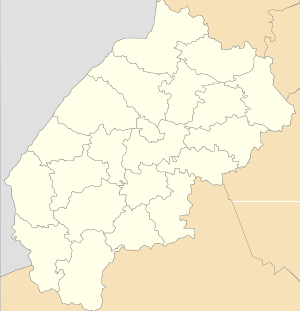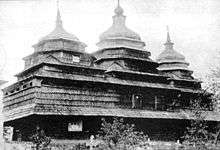Lavochne
Lavochne (Ukrainian: Ла́вочне, Polish: Ławoczne) is a village (selo) in Skole Raion, Lviv Oblast (province) of Western Ukraine (until 1959 belonged to Drohobych Oblast). The village has 1198 inhabitants and local government is administered by Lavochnenska village council.[1]
Lavochne Лавочне | |
|---|---|
 Lavochne | |
| Coordinates: 48°48′26″N 23°21′19″E | |
| Country | |
| Province | |
| District | |
| Established | 1591 |
| Area | |
| • Total | 2,64 km2 (102 sq mi) |
| Elevation /(average value of) | 663 m (2,175 ft) |
| Population | |
| • Total | 1,198 |
| • Density | 453,79/km2 (117,530/sq mi) |
| Time zone | UTC+2 (EET) |
| • Summer (DST) | UTC+3 (EEST) |
| Postal code | 82652 |
| Area code | +380 3251 |
| Website | село Лавочне (Ukrainian) |
Geography
The village is located at the railway line Lviv - Chop.
Railway line Mukachevo - Svalyava - Lavochne was constructed in 1881, in 1887 being transformed to Lviv - Stryi - Chop. Lavochne station building has been opened in 1886.
Lavochne is situated 146 kilometres (91 mi) far from the regional center Lviv, 41 kilometres (25 mi) from the district center Skole and 10 kilometres (6.2 mi) from the urban village Slavske .
History

The first written mention of the village refers to 1591, when it was a part of Ruthenian voivodeship of Rzeczpospolita.[2] In the years 1772-1918 Lavochne was part of Kingdom of Galicia and Lodomeria under Austrian rule. After the dissolution of Austria-Hungary Lavochne became part of the Second Polish Republic, serving as the border railway station - first on the Polish-Chekhoslovakian border (till March 1939), then Polish-Hungarian border. After the Invasion of Poland Lavochne found itself on Soviet territory. In 1941-1944 Lavochne was part of the Third Reich's District of Galicia. Lavochne was the last Ukrainian settlement liberated from the Nazi occupation on October, 8th, 1944.[3] Since that time Lavochne is part of Ukraine (in Drohobych Oblast till 1959, then in Lviv oblast).
There is an interesting version of the origin name of the village Lavochne. In order to cross the river been stacked wood benches (lavka, Ukrainian: лавки).
Cult constructions and religion

There used to be an architectural monument – wooden church of St. Michael, 1907 (1415 / 1).[4]
On July 10, 2012 a wooden church has been burned down.[5] In its place another church, also wooden, has been built.
Mentions in literature
Lavochne is the hometown of heroes of Mirjam Pressler's novel "Malka Mai".
References
- Лавочненська сільська рада (in Ukrainian)
- (in Ukrainian)
- "Який населений пункт Закарпаття був визволений останнім?". Новини Закарпаття. Archived from the original on 2016-01-26. Retrieved 2016-01-19.
- Пам'ятки архітектури Сколівського району (in Ukrainian)
- Замки та Храми України, Лавочне (in Ukrainian)
External links
Literature
- Історія міст і сіл УРСР : Львівська область, Тершів. – К. : ГРУРЕ, 1968 р. Page 717 (in Ukrainian)